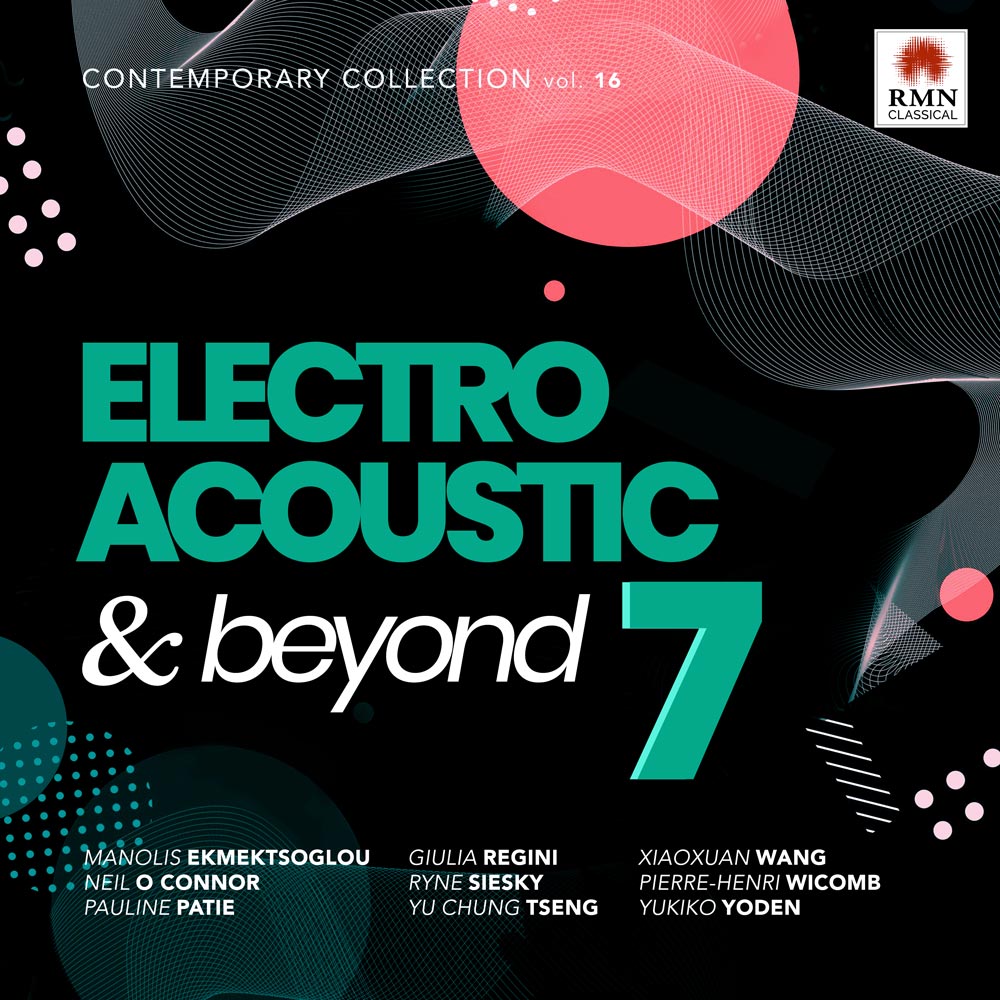MUSIC > Electroacoustic & Beyond 7

Title: Electroacoustic & Beyond 7
Release Date: 14 Oct 2022
Label: RMN Classical
Produced by R. Romano
Cover design by RMN Classical
Electroacoustic & Beyond 7 by Various Artists
| N. | Play | Title | Composer | Time |
| 01 | Bog Braon | Neil O Connor | 07:49 | |
| 02 | Mirage | Yukiko Yoden | 03:36 | |
| 03 | Etude on Voice | Manolis Ekmektsoglou | 02:48 | |
| 04 | Surtitré | Pauline Patie | 06:02 | |
| 05 | BLABLABLABLABLAVET | Pierre-Henri Wicomb | 04:53 | |
| 06 | The Phoenix Songs II | Xiaoxuan Wang | 05:08 | |
| 07 | Tai Chi Qishi | Yu Chung Tseng | 05:19 | |
| 08 | Brushstrokes | Giulia Regini | 05:53 | |
| 09 | …grind… | Ryne Siesky | 08:12 |
Lullabies and femininity come together through the biological role of child-bearer, and the societal role of caregiver to the extent that femininity and motherhood are often embedded into and implicit within lullaby singing. These attributes strongly support the assumption that lullabies are traditionally a form of feminine practice and narrative discourse.
Bog Broan is such a traditional Irish lullaby, sung by Sean Nos singer, Muireann Nic Amhlaoibh. Both the string players react to the motifs on the graphical score while the electronics are spectral reconstructions of Muireann’s vocal phrases.
In the Europe of the 60s-70s an exchange of concepts between the electroacoustic and instrumental composers was observed which linked the two sides: the French composers applied concepts and techniques of the Cologne studio to instrumental music (French Spectral) and the German composer Helmut Lachenmann applied concepts and techniques of the Paris studio to the instrumental domain (Musique Concrète Instrumentale). Simultaneously with the two schools, Iannis Xenakis came up with his random concepts.
In this work, the composer uses an M4L device developed in an effort to compose electroacoustic music combining the concepts of the three schools: recorded sound samples, studio-produced sounds and random application. The M4L device comprises real-time randomized delay plugin parameters that allows the composer to compose without using any additional processing. No filtering, panning, plugins or external stand-alone devices are applied therefore pushing this approach towards a more "purist" one.
The looped sound sample used comprises a 22-second long excerpt from a mixed composition of the composer.
"Silence contains all truths; speech carries all lies."
-Jacques Ferron
Ally or traitor, language musicalizes the richness of thought. How many possibilities are there for language to say the same thing? How many words are necessary to say nothing? Is the word only capable in its song of offering freedom to our thought?
In this work, the composer has expressed this idea by the contraction and expansion of sound: a formal representation of the articulation of words, struggling with the meanderings of thought.
The work was commissioned by a South African flautist and academic, Esther-Marie Pauw, stipulating the creation of an electroacoustic piece as a response to her recording of the flautist-composer Michel Blavet’s solo flute piece Gigue and Rondo.
The electroacoustic work BLABLABLABLBLABLAVET is a compositional contemplation exploring the unfamiliar situation and setup found in this undertaking of creating in tandem with a complete recording of a piece.
BLABLABLABLABLAVET is a work which occupies itself with the concealment of the original recording, unfolding as a playful, cracked collage attempting to keep the Gigue’s spirit intact (including a sense of tonal gravity). The original recording underwent filtering (often underscoring frequencies under 700Hz) to emphasise certain notes and highlight internal rhythmical activity. Further treatment of the flute sound includes pitch manipulation, distortion, delay effects and editing.
The phrase construction of the original work had a definite influence on BLABLABLABLABLAVET’s construction, with the regularity and driving qualities of the Gigue taking on a similar role in this work. Esther’s performance was meticulously duplicated to create Midi data implemented for the triggering of a few virtual instruments. This ‘version’ also created the compositional possibility and more control over the dissolving and re-structuring of small rhythmical and pitch elements of the original material.
The work, inspired by the phoenix (a symbol of good fortune and immortality in traditional Chinese culture) is a calling for people to be more aware of environmental protection.
Composed in 2021, this electronic music piece uses samples from a high-pitched Suona (a wind instrument with a distinctive timbre among Chinese folk instruments) to evocate what the sound of the phoenix could be. Such sound collide with the wooden instruments to create an atmosphere of change, almost like a mythical place where weather and birds live in harmony with nature and humans, mountains and forests.
At the same time, electronic music is also used to present the characteristics of Chinese folk music and musical instruments, adding a Chinese folk "flavour" to the work and allowing the listeners to capture the Chinese sound in it.
Tai Chi Qishi was composed to convey the momentum of Chinese Tai Chi, an internal Chinese martial art practiced for defense training, health benefits, and meditation. Tai chi has practitioners worldwide.
The main thought and emphasis of the work were particularly placed on expressing the diverse modes of Tai Chi Breathing. The main sound sources of Tai Chi Qishi were mainly drawn from recorded vocal fragments of the composer himself. The sources were then manipulated and modified through various techniques of digital audio signal processing, including FFT-based phase vocoding, granular synthesis, reversal, speed change, and filtering, to create most of the desired sound timbres and sonic gestures of this composition.
Different types of processed sounds allow the composer to construct an image of the flow of breathing and help to achieve the main artistic idea of the work. Among these: 1. the significant use of human breathing noises as the main sound source; 2. the use of “surrealistic” phase vocoding; 3. extremely long-stretched human breathing noises; 4. the use of various outburst human breathing noises; 5. the prominent use of dramatic envelope-shaped noises (e.g. molto cresc. and sudden-cut noises); 6. the eminent use of voice “ha” with much breathing noise; and 7. the prominent employment of various filter-coloured human breathing noises of “S” sounds.
The overall form of the work reminds a multi-sectional structure frequently employed in Chinese Music where each section is self-contained and departs for its own new sound journey with distinct sonic gestures and timbres.
Tai Chi Qishi was created and finished at the Sound Lab at National Yang Ming Chiao Tung University (NYCU) in Taiwan in 2019.
Brushstrokes is a composition inspired by the painting La città che sale (1910-1911) by Umberto Boccioni.
With this work, the composer tried to interpret the painter's message and the thought of the Futurist artistic movement. The ideology of exaltation of modernity, machines, speed, of the industrial city and the overcoming links with the past, has been reinterpreted with a critical eye. The soundscape is that of the modern industrial city that the futurists were interested in.
The development, represented by the horses, is therefore indomitable and uncontrollable. The way the processed sounds are then utilized is an attempt to follow the author's gesture, “the brushstroke”.
This interpretation aims at conveying the Futurist message.
A strong concept is the bones of the work: each year, approximately five hundred billion plastic cups are used, of which roughly six billion cups end up in landfills every year.
"...grind..." utilizes a one-second sound, a plastic Keurig coffee pod hitting the floor, which morphs into more destructive sound forces, symbolic of the faulty business and political ideologies that ultimately contribute to a lack of environmental sustainability.
…grind… was inspired by the Fair Trade coffee initiative at Donkey Coffee (Athens, OH)

